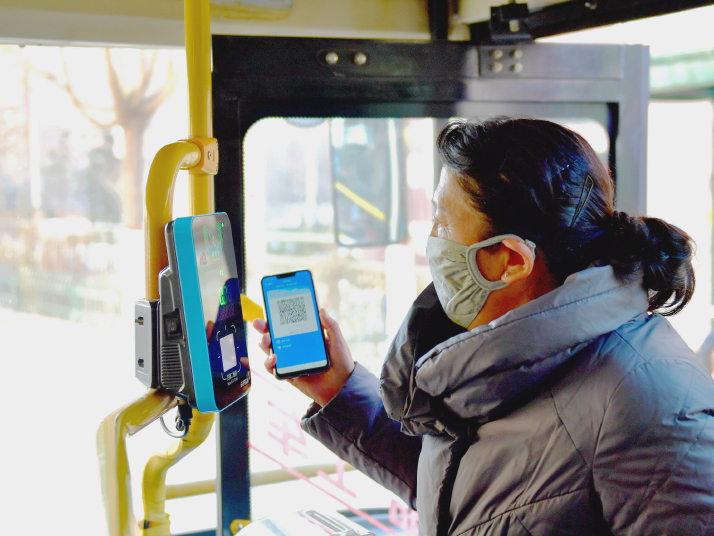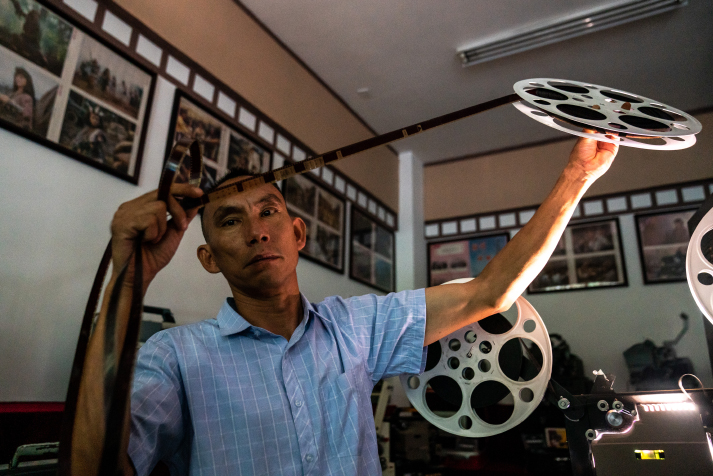| Lifestyle |
| While progress makes some items obsolete, others are hanging in there | |
|
|
 A resident uses a QR code to take a bus in Xining City, Qinghai Province, on November 22, 2018 (XINHUA)
Paying with a mobile phone has become so natural to the vast majority of the Chinese population in recent years that they can actually live without any paper money or a wallet, thanks to the country's two most famous third-party digital payment apps—Ant Group's Alipay and Tencent Holding's Weixin Pay. The prevalence of mobile payment for Chinese consumers was confirmed by a 2021 report based on a survey of over 50,000 respondents by the Payment & Clearing Association of China. In 2020, 74 percent of respondents used mobile payment daily. Among mobile payments, scanning QR codes was the most commonly used method, accounting for 95.2 percent, according to the report. China has become a largely cashless society thanks to e-payment apps and a large number of smartphone owners. China is far ahead of any other country in terms of the number of smartphone users, according to Newzoo, a source of data and research for the games industry. With more than 950 million users in 2021, the Chinese smartphone market is larger than those of India, the U.S. and Indonesia combined. Mobile payment has brought great convenience to the lives of many China residents, but it has also brought "cash discrimination" as some merchants have become reluctant to accept cash payments, which is especially unfriendly to senior citizens who often still have no or limited access to digital life, in particular those residing in the country's relatively underdeveloped areas. Renminbi cash is China's legal tender and the country's most basic and fundamental payment tool, and it is crucial for meeting the public's diversified payment needs, according to the statement of a meeting of the People's Bank of China, the country's central bank, on October 25. The statement said the country will continue to crack down on the illegal act of cash refusal and improve the convenience of cash use. Either way, cash is just one example of an item that has been used less and less in recent decades. With China's development and constantly evolving technology, a host of other physical items are slated to gradually become obsolete. A rare sight Traveling around a city using public transportation previously required a physical transit card or a one-way ticket. One example thereof in the capital city is the Yikatong, an intelligent transit card that was first issued in 2006. The physical card requires a 20-yuan ($2.8) deposit, and users had to go to a service outlet or a vending machine to recharge the card in the past. If you lost your card, you lost your money. But today, users can recharge the physical card via the Beijing Yikatong app on their smartphones through near field communication (NFC) technology. Moreover, the Beijing Subway has also enabled payment via QR code on Alipay. Subway riders can open the app on their smartphones, search for "Beijing Subway," obtain the QR code, and then scan it to enter the subway station. Beijing has also introduced Alipay QR code payment on all public buses. According to news portal People's Daily Online, statistics from Alipay indicated that more than 200 cities in China had enabled this service as of May 2021. Today, a physical transit card has become a rare sight. Other items going out of style belong to the nation's film industry. Around 1980, film teams of two or three projectionists each were formed in villages and towns throughout China. Their mission was to promote culture and agricultural science among the country's rural population. Villages would pay for the films so that locals could watch them free of charge. At that time, the rural film projectionists had to take heavy equipment with them on their village tours, including traditional film projectors, canisters holding cine film, audio equipment and even power generators. "In the beginning, we had to carry with us a generator, a projector and canisters, totaling at a weight of more than 100 kg," Liu Liang, a 58-year-old rural film projectionist in Shaoyang County, central Hunan Province, said in an interview with Xinhua News Agency in 2020. Today, digital projectors have replaced the heavy traditional ones, Liu said. In recent years, people in China have also been discussing the disappearance of the television, once the center piece of collective attention in the living room of a household. According to The Beijing News, in 2022, China's television sales stood at just 36.34 million units, the lowest sales volume in the past decade. And the downturn continues. Data from All View Cloud, a big data service provider, showed that in the first half of 2023, China's color TV market sales were 14.67 million units, a year-on-year decrease of 12.2 percent, amounting to 48.7 billion yuan ($6.7 billion), a year-on-year decline of 8.5 percent. Some netizens, across a range of Chinese social media platforms, confessed that although they do have a television at home, they rarely turn it on. The home projector and a myriad of online video media platforms are challenging the position of the once beloved piece of furniture.  A rural film projectionist looks at cine film at a film exhibition studio in Nujiang Lisu Autonomous Prefecture, Yunnan Province, on October 23, 2022 (XINHUA)
A new picture develops But new things do not always completely replace old ones. A good example here is that when the digital camera became popular, many photographers, including amateur ones, decided to stick with or go back to analog photography, also known as traditional or film photography. "Film photographers, with a limited number of exposures available on a roll of film, must think more about their images before shooting them. Digital photographers tend to take pictures first and think later," Zhang Hang, a Shanghai-based photographer told Beijing Review, adding that even though using a film camera requires more preparation, this also means the creative juices will start flowing and you are likely to come up with more or novel angles. Some netizens have said they prefer the color tone and texture of film photos. "In addition, developing film in a darkroom also requires good technique, and the details will determine the quality of the final photo. So I think digital photography is result-oriented creation, whereas film is process-oriented," Zhang said. "It's hard to say which is better, and new things do not (necessarily) displace the old." Some items of the past, though no longer used in daily life, are still cherished. Enamel washbasins with the double xi, the Chinese character for happiness, were once an integral part of a bride's dowry in China. Today, enamel washbasins have been replaced by plastic ones or by other modern household appliances. But in collector Wang Yanping's studio in Beijing's Shunyi District, one wall is adorned with these washbasins. The old things, a mirror of the development of Chinese society and culture, should be remembered, Wang told Beijing Review. Wang also expressed her hope that her collections and exhibitions will enable more people at home and abroad to get in touch with Chinese culture and China's social development. She also hoped to see more creativity in combining modern elements with traditional ones, to create items more appealing to China's younger generations. (Print Edition Title: The Good Old Things) Copyedited by Elsbeth van Paridon Comments to taoxing@cicgamericas.com |
|
||||||||||||||||||||||||||||
|
